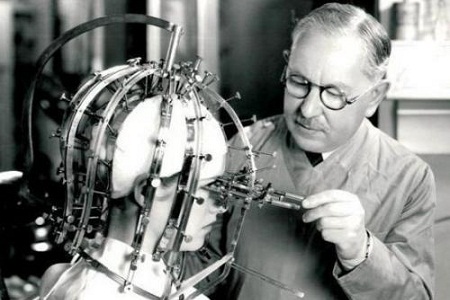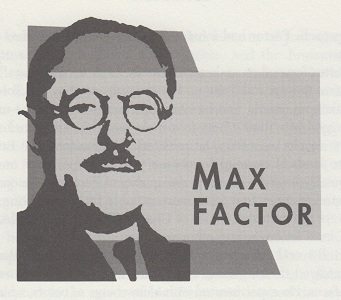Born: June 16, 1872, Lodz, Poland
Died: August 30, 1938, Beverly Hills, CA
Even Lon Chaney bowed to Max Factor’s makeup expertise.
—Fred Basten
The first makeup designed expressly for motion pictures was created by Max Factor in 1910, when he came to Hollywood to service the needs of more than 150 small independent studio lots that sprinkled the Southern California coastline. Sensing the wealth of opportunity, Factor decided to concentrate his efforts solely on creating the cosmetic products for the fledgling film industry. He quickly became the biggest name in movie glamour, and his innovative products reached far beyond Hollywood.
The first Factor innovation was the use of wigs. When called upon by Cecil B. DeMille to help outfit cowboys and Indians for The Squaw Man (1914), Factor interested the director in a new approach. Hollywood had been using wigs made of straw, tobacco and Spanish moss in the silent days of moviemaking, but with the increasing use of close-up shots, the unnatural patches of hair were painfully obvious. For a more realistic look, Factor suggested wigs made with genuine human hair. When DeMille balked at the cost, Factor offered to rent the wigs to ease the picture’s budget. Wig rentals proved to be a huge boon for Factor’s business. He became the major supplier of wigs to almost all studios in Hollywood for half a century. The famous rugs that Max designed over the years were worn by John Wayne, Frank Sinatra, Fred Astaire and Jimmy Stewart. To round out his full-service approach, Factor had most of his clients’ wigs delivered directly to set locations.
Next, Factor focused on makeup essentials. In those early days, many stars were reluctant to wear full makeup. For example, cowboy star Tom Mix considered makeup unmanly, and he simply refused to wear any—until Factor had the rugged Mix filmed next to a male model wearing makeup. When Mix saw the results on screen, he relented. Other actors, like Lon Chaney, had favorite kinds of makeup from their years of experience on the stage, but most quickly bowed to the superior quality of Factor’s greasepaint, which was graduated in tones that were more suitable for film lighting. Soon, his products were the exclusive choice of Charlie Chaplin, Buster Keaton, Mary Pickford, Gloria Swanson and others.
When Hollywood cameramen began using panchromatic film in 1928, they standardized their lighting, and Factor noticed an unnatural effect in the actors’ faces. He experimented with a new range of colors, which resulted in products called panchromatic makeup, an achievement that won him a special Oscar that same year. He was also alert to the effects of Technicolor film, which caused images to appear yellow, red or blue, and soon found a solution. For Vogues of 1938, starring Joan Bennett and dozens of attractive models, he developed special base that yielded a matte finish, which did not reflect light from nearby colors into the camera. For both of these special considerations, Factor developed a solid block of makeup—a “cake”—that could be applied with a moist sponge; he housed the innovative product in a small tin canister and called it Pan-Cake makeup. It soon became extremely popular. In fact, on the set of The Goldwyn Follies (1938) a property clerk noticed that all of the tins filled with Pan-Cake makeup were disappearing. Apparently the dancers fancied the new product and were running off with it. The studio estimated the theft at hundreds of dollars a day. Amused and flattered, Factor released the makeup to the public that same year. The popular application created a revolution in women’s cosmetics; Pan-Cake makeup became the fastest-selling product in the history of the cosmetics industry and is still used today.
He also invented many of the essential tools used by makeup professionals and consumers alike: the lip brush, powder brushes for smooth distribution of makeup, even a series of booklets for actors on the basic principles of character makeup. He popularized the concept of color harmony—matching lipstick to the color of a woman’s hair, or color-coordinating the actor’s face with the costume or setting.
Factor’s prominence within the Hollywood community increased with each new starlet. When Greta Garbo arrived from Europe, Louis B. Mayer had her taken straight from the airport to Max Factor’s studio for a consultation. Some actresses completely entrusted themselves to him in their search for a trademark look: the striking, dark chiseled features of Joan Crawford, the vampy platinum blondeness of Jean Harlow and the brassy red hair of Lucille Ball were all the work of Max Factor. In exchange for his services, Max would have starlets sign a token one-dollar contract with him that allowed him to use their image and endorsement on any or all of his products. Then he would advertise the exclusivity of his “contracts” with such stars as Bette Davis, Janet Gaynor, Rita Hayworth and Ginger Rogers and feature their faces in campaigns aimed at American housewives. In fact, Factor set up sales counters inside many of the Los Angeles theater lobbies to catch women who might have just watched a movie starring a particularly glamorous Max Factor client.
In 1937, he traveled to Europe to open a series of salons. Returning after a similar trip in 1938, he died at the age of sixty-six. Max Factor came to California to start his own salon and found himself starting a global corporation. He adapted to the needs of his clients and learned the craft of filmmaking innately; his pioneering products are the standard for movie makeup to this day. Over twenty-nine years, his dedication to the serving Hollywood continued even after his death, when his son took over the family business and solved new makeup problems on television with Lucille Ball’s famous show. Today, the Max Factor name symbolizes a standard of quality in consumer cosmetics worldwide.
To read all the republished articles from ‘The Film 100,’ go to Reintroducing the Film 100 here on Keyframe.





